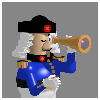
|
RESPONSE
|

|
CLIENT-SIDE
(the BROWSER)
THE TOP TIER
aka FRONT-END
NETSCAPE/FOXFIRE
OPERA/MOZILLA |
|
HTML/CSS/XML/DOM
Java Applets
Javascript
|
or
| MS INTERNET EXPLORER | |
HTML/CSS/XML/DOM
Javascript
Java Applets
VBScript/Active-X |
|
 |
|
REQUEST
A Request in its simple form is just a URL (a passive request for an HTML file stored on the server). However, user provided data and a program to be executed may also be passed to the server with the Request. The data is acquired from the user using HTML Forms. The data is attached to the end of the URL as a string composed of name-value pairs (variable names and their values in pairs). This string is called the QueryString. The URL and a QueryString are connected by:
- ?
- the QueryString (i.e., the data the user entered on the Form) in name-value pairs:
- name of the first variable on the Form, then
- =
- then the value of the first variable
- then an & character to terminate the pair
The following is an example of a QueryString with two name-value pairs attached to a URL:
URL?v1=5&v2=3
The Request is composed of:
- the URL
- ? (to separate the URL and QueryString)
- v1 (the first variable name from the Form)
- =
- 5 (v1's value),
- & (to separate the name-value pairs)
- v2 (the second variable name on the form)
- =
- 3 (v2's value)
The URL contains three parts:
- a website (a domain name)
- a path
- either:
- the name of an HTML file (*.htm or *.html)
or
- the name of a script or program to execute on the server. Either:
- *.cgi for compiled C programs
- *.pl for interpreted PERL scripts
- *.asp for active server scripts
- *.aspx for compiled DOT.NET programs
(either VB.NET or C#)
- *.jsp for java server pages (scripts)
- *.php for personal home pages (php) scripts
These programs or scripts can use any data passed in the Querystring from the HTML Form.
For example:
http://www.abc.edu/cgi-bin/xyz.cgi?v1=5&v2=7
is interpreted as:
- http://www.uh.edu is the web site (domain name)
- /cgi-bin/ is the path
- xyz.cgi is the name of the compiled C program to execute
- ? separates the URL and the QueryString
- v1=5&v2=3 is the QueryString discussed above
|
|

|

















